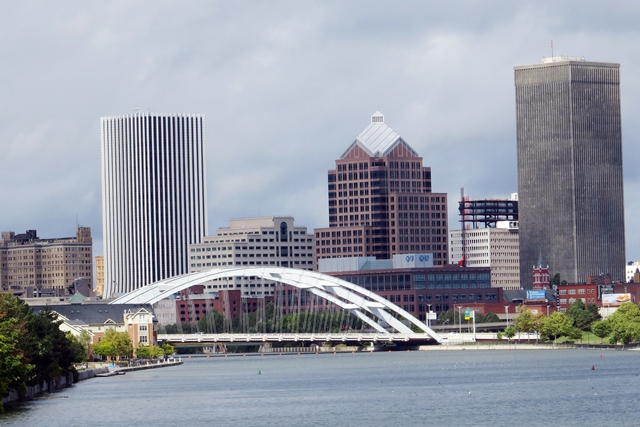
Rochester, New York, one of the cities highlighted as a future high-growth technology hub. (A. Kotok)
9 Dec. 2019. Growth patterns in the U.S. show a concentration of technology development in a few cities, with new policies and investments needed to encourage innovation elsewhere. These findings are outlined in a report issued today by the Brookings Institution, a public policy research institute, and Information Technology and Innovation Foundation, both in Washington, D.C.
The Brookings/ITIF analysis shows employers in the U.S. based on advanced industries, those investing in and incorporating the latest technologies in their products, are increasingly located in a very few population centers. Their findings show just five metropolitan areas — Boston, San Francisco, San Jose, Seattle, and San Diego — account for 90 percent of the nation’s growth in innovation-based employment from 2005 to 2017. Since 2005, these five cities increased their share of the country’s total innovation-based employment from 18 to 23 percent. At the same time, the 343 metro areas making up the bottom 90 percent of employment in advanced technologies reduced their share of these workers.
The result, say the authors, is “a grave national problem,” with negative consequences for both the cities left behind and the superstar regions attracting a larger share of advanced technology employees. The high concentration of technology industries in a few cities means the most highly trained workers from the top universities are also congregating in those metro areas, making it more difficult for employers in other regions to hire the best workers. In addition, more private investment is concentrating in these higher-growth areas, with the rest of the country increasingly losing out.
And even for the so-called winners, the high concentration of advanced technology employment comes with steep costs. These high-tech hubs, for example, face escalating residential prices and traffic gridlock, making day-to-day life more difficult. As a result, companies in advanced industries are looking off-shore for lower-cost future sites with highly trained workers, rather than less-expensive American cities that are not attracting a more educated workforce. This increasing divergence, say the authors, is also driving some of the backlash politics from areas left behind in the U.S.
The authors note that neither market forces nor local initiatives alone are enough to change this pattern. The combination of high-tech worker concentration and accumulation of investment capital in a few metro areas feeds a self-perpetuating cycle that eclipses classic market economics. The size and complexity of the problem, says the report, requires public policies and resources on a national scale, as well as solutions identifying specific regions for attention.
The report identifies 35 metro areas in 19 states, most of which are far-removed from the current superstar cities, with the potential to become high-growth technology centers. The authors recommend that the federal government select eight to 10 of these cities after an open competition, and invest $700 million a year in R&D funding in each of the cities for 10 years to jump-start their transformation. The authors also point out that federal policies in the past sited national labs and other technology centers in specific regions, notably Boston, the bay area in California, and North Carolina’s research triangle.
“The nation’s tech-driven spatial divides have reached emergency status and won’t resolve themselves on their own,” says Mark Muro, a senior fellow/policy director at Brookings and an author of the report, in an institute statement. “It’s time for the nation to push back against these trends and conduct a major experiment to see if we can help eight to 10 promising metros emerge as really dynamic anchors of growth in the nation’s heartland.”
More from Science & Enterprise:
- Infographic – Manufacturing Declines Worldwide
- Infographic – Govt Research Funds Fall Behind in U.S.
- Infographic – Private R&D Outpacing Defense Contractors
- Infographic – Partisan Split Remains on Research Spending
- Stanford, Berkeley, MIT Top Undergrad Start-Up Ranking
* * *

 RSS - Posts
RSS - Posts
[…] Report – U.S. Needs Regional Technology Centers […]